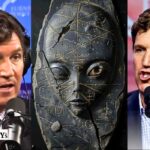In the distant past, Earth was inhabited by many civilizations, some of which are well-known while others remain a mystery till now. There are legends of giants in the many ancient cultures throughout the world but with time, they have become a myth. In the last century, many artifacts and evidence of abnormally large bones showed up that sparked the theories that say that the giant beings lived among humans thousands of years ago.
In 1929, Detroit Free Press published this story of an alleged mysterious race that inhabited Catalina Island 3000 years ago.
For over 13,000 years, the cluster of islands off the California coast continued to reveal the mysteries of ancient times that scientists are still trying to explain. These islands are the home of over 2000 plants and ancient species. Among them, Santa Catalina Island (also known as Catalina Island), located 22 miles from Long Beach, attracts the attention of various historians.

Catalina Island has an interesting history. It was originally settled by Native Americans known as Gabrielino-Tongva Indian tribes in around 7000 BC. In 1542, explorer Juan Rodríguez Cabrillo called it the island and made it a Spanish crown. Then in 1846, it was possessed by Mexico and finally purchased by the United States real estate speculator at the end of the 19th century. It is claimed that at the beginning of the 20th-century, the ancient burial ground was uncovered by a man named Ralph Glidden who moved to the island with his parents in 1896.
He had worked as a carpenter before he found interest in the Indian artifacts and the ancient burial sites he found at the different places on the Channel Islands. Between 1919 and 1928, he uncovered numerous ancient burial sites on Catalina Island, finding human bones and skeletons.

During the excavation, Glidden claimed to have found alleged 800 burial sites and a myriad of Indian artifacts and relics, as well as thousands of ancient natives’ remains which he used to sell and trade to the museums and collectors. He is said to have excavated more than 800 gravesites from various locations around the island, including thousands of artifacts and 4,000 human skeletons.
Read also:
- DNA Tests Reveal 3,000-Year-Old Paracas Skulls Are Of Unknown Human Race
- Mysterious Golden Orbs, Hidden For 1800 Years, Found Beneath Ancient Mexican Pyramid
- Metal Library Of Ecuador: Ancient Astronauts’ Time Capsule With Detailed Instructions To Mankind?
In 1924, Glidden opened a museum he called “Catalina Museum of Island Indians,” where he publicly displayed his discoveries. He described his “Indian museum” as a “unique and weirdly spectacular institution,” with shoulder-blade cornices and windows edged with toe, ankle, wrist, and finger bones. Leg and arm bones served as brackets for shelves lined with skulls. Ceiling panels were decorated with human vertebrae and rosettes of shoulder blades.
Among the most curious discoveries made by Glidden, the most outlandish one was his claim that he found a mythical prehistoric race of fair-skinned blue-eyed giants, with adult males measuring 7 to 9 feet in height, once inhabited Santa Catalina and its adjacent islands.

Interestingly, in 1913, German Dr. A.W. Furstenan found an 8-foot human skeleton. Supposedly, it was discovered in hard black sand and was mostly disintegrated when it was brought to the surface and exposed to air, leaving only the skull, jawbone, and foot intact. Besides, there is another report that found a giant skeleton of a 7-foot-tall person, which had double rows of teeth and 6 fingers and toes. The double rows of teeth were common in the human remains found in the Channel Islands. Similarly, San Nicolas Island was also the hub of larger human skeletons that supposedly belonged to a different race.

John Johnson, Ph.D., a curator of anthropology at the Santa Barbara Museum of Natural History said: “With regard to the ‘giants’ of Santa Catalina Island, “these reports are apocryphal, as far as I have been able to determine. For example, there’s a historic photo of Glidden in the background and the burial in the foreground, merely creating an illusion that the skeleton is somehow a giant.”
According to historical records, Glidden’s career was short-lived. He stated that the alleged giant skeletons he had found were buried in a ceremonial fashion. He surmised that the local natives worshiped them as some sort of gods. Obviously, his research was seen as skeptical in the mainstream media and chalked up to being a money-making scheme. Some people said that he bought the fake skeletons from a curio shop on Broadway in Los Angeles. A paranormal researcher named L.A. Marzulli backed Glidden and said that on a detailed analysis of one of his photos, showing an 8.5-foot-tall skeleton, seems to be real. He also noted that one of the giant skeletons clearly showed 6 fingers.
Glidden died in 1968 at the age of 87. He reportedly sold his collection to the Wrigley family for $5,000 who later donated it to the Catalina Island Museum.









Basically he was a grave robbing bastard.
Skulls with double rows of teeth, and 8 foot skeletons, and all you get out of this article is the need to ridicule the guy who found them…..